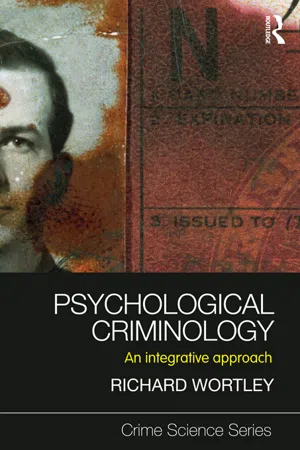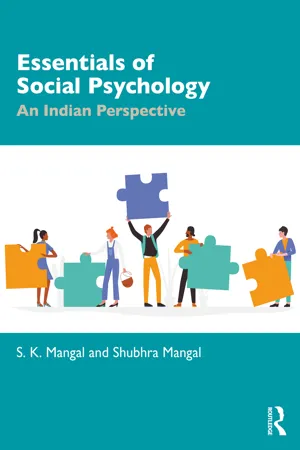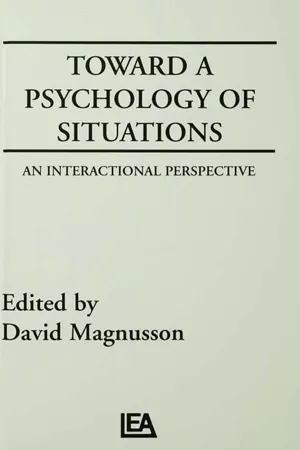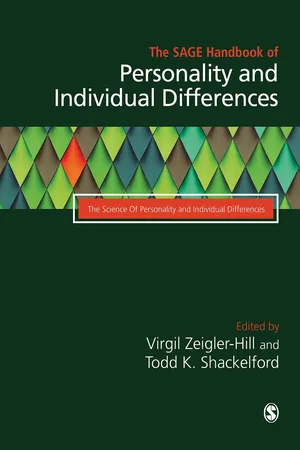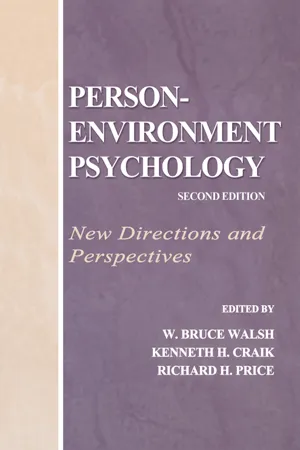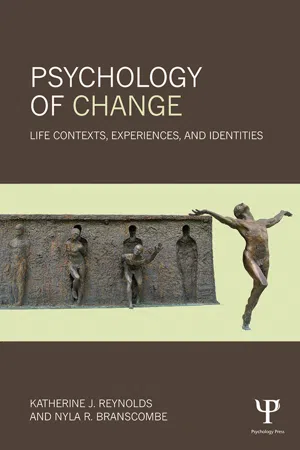Psychology
Situational Influence
Situational influence refers to the external factors that can impact an individual's behavior, thoughts, and feelings in a given situation. These factors can include the physical environment, social norms, cultural expectations, and other situational cues. Situational influence is an important concept in understanding how individuals respond and adapt to different contexts and settings.
Written by Perlego with AI-assistance
Related key terms
7 Key excerpts on "Situational Influence"
- eBook - ePub
Psychological Criminology
An Integrative Approach
- Richard Wortley(Author)
- 2011(Publication Date)
- Willan(Publisher)
The examination of Situational Influences on criminal behaviour was begun in the previous two chapters. In those chapters, situations were viewed largely through the eyes of the offender, that is, we examined the way that individuals interpret and react to their personal environment. The situational factors contributing to crime tended to be specific to the individual, based on his/her particular learning history and/or cognitive style. In this chapter we work in the other direction, beginning with situational factors and examining their impact on individuals. Theories that examine situations in this way tend to be concerned with the way that immediate environments affect people generally rather than with individual differences in situational effects. Two psychological perspectives – social psychology and environmental psychology – are dedicated to the examination of the effects on behaviour of the immediate environment. Social psychology focuses on the social environment, examining the psychological effects on individuals of the presence of others. Environmental psychology focuses on the physical environment, examining the psychological effects on individuals of factors associated with built and natural environment. A third perspective, this time from criminology, is also relevant to the analysis of situations, and that is the focus on opportunity. Opportunity theories – which may examine both social and physical environmental factors – simply assert that crime occurs where it can occur, a principle summed up in the well-known saying ‘opportunity makes the thief’. Before examining these three perspectives, we will have a closer look at just what a ‘situation’ is.What is a Situation?A situation is the setting in which behaviour occurs. Situations have both spatial and temporal dimensions: they are specific locations at particular points in time. Situational factors include tangible elements such as the physical aspects of the immediate environment and the behaviour of the people who are present. Somewhat less tangibly, situations can also refer to a state of affairs or set of circumstances at a given moment. A funeral and a wedding, for example, both may involve friends and relatives packed into a church, but the behaviour of the respective congregations will be shaped by the circumstances of the occasion. A clearer idea of what a situation is can be gained by examining the ways in which the term has been operationalised in psychological and criminological research. - eBook - ePub
Psychological Criminology
An Integrative Approach
- Richard Wortley(Author)
- 2023(Publication Date)
- Routledge(Publisher)
The examination of Situational Influences on criminal behaviour was begun in the previous two chapters. In those chapters, we examined the psychological processes by which an individual experiences, interprets, and reacts to the immediate environment. In learning theory, the immediate environment is the source of rewards and punishment that encourage or discourage the performance of learned behaviours. In cognitive models of behaviour, immediate environmental data feed into the decision of how to act in a given circumstance. In this chapter, we shift focus to the situational factors themselves; specifically, we examine the sorts of immediate environmental conditions that are conducive to crime. We examine the role of situational factors through three theoretical lenses – social psychology, environmental psychology, and opportunity theory. Social psychology focuses on the social environment, examining effects on behaviour of the presence of others. Environmental psychology focuses on the physical environment, examining the effects on behaviour of the built and natural environment. Opportunity theory – which includes both social and physical environmental factors – simply asserts that crime occurs where and when it can occur, a principle summed up in the well-known saying ‘opportunity makes the thief’. Before examining these three perspectives, we take a closer look at just what a ‘situation’ is.What is a situation?
A situation is the setting in which behaviour occurs. Situations have both spatial and temporal dimensions – they are specific locations at specific points in time. Situational factors include tangible elements such as the physical aspects of the immediate environment and the behaviour of the people who are present. Less tangibly, situations can also refer to the social or symbolic context. A funeral and a wedding, for example, may involve friends and relatives packed into a place of worship, but the behaviour of the respective congregations will be shaped by the circumstances of the occasion. A clearer idea of what a situation is can be gained by examining the ways in which the term has been operationalised in psychological and criminological research. - eBook - ePub
Essentials of Social Psychology
An Indian Perspective
- Shubhra Mangal, Shashi Mangal(Authors)
- 2022(Publication Date)
- Routledge(Publisher)
- It tells us that our thoughts, feelings and actions are influenced with the interactions and presence of others and vice versa. Proceeding further, it acquaints us with the way these are influenced in the presence of others in one or the other social situations. In other words, thus, social psychology may be found to look at human behavior as influenced by other people and the social context in which this occurs.
- For influencing and affecting our feelings, thoughts and actions, the actual presence of others is not essential. It can happen also with their imagined and implied presence such as when watching television or following internalized cultural norms.
- Social psychology provides a scientific explanation of what, how and why people think, feel and behave the way they do with others, influence them and have interactions and relationships with them in one or the other social situations.
- It helps us in understanding and explaining the manner in which our thoughts, feelings and actions influence others or get influenced in the presence/interactions with others. Apart from the ongoing behavior of others, social experiences preserved in our memory, and the attitudes formed out of these experiences, and physical factors also influence our behavior towards others.
Social PsychologyAn applied branch of the subject psychology that deals with the scientific study of the behavior of individuals in a social context enabling us to get an explanation of the nature and causes of their thoughts, feelings and behaving with others in one or the other social situations.- In this way, what is available in the form of social as well as other variables to us in our social environment at one or the other time, proves quite significant in influencing our bent of mind (in terms of our attitudes, perceptions and motives) and our actions and behavior at that time and also in future in the similar encounters. By highlighting all such things, social psychology tries to bring out all the factors that lead us to behave in a given way in the presence of others, and look at the conditions under which certain types of behavior/actions and feelings occur.
- eBook - ePub
Toward A Psychology of Situations
An Interactional Perspective
- D. Magnusson, David Magnusson(Authors)
- 2013(Publication Date)
- Psychology Press(Publisher)
By selecting (or being born in) a city, as opposed to a rural area, we are more likely to encounter subways, tall buildings, and areas of high population density and less likely to encounter farm animals and unpolluted air. By deciding to go to the university we are probably eliminating (manual) labor occupations such as farm hands, assembly line operators, or taxi drivers and minimizing the opportunity of interacting with persons in these occupations. By deciding to go into graduate school, in psychology, for example, we are further limiting the situations (including other persons) we encounter. Most of us are creatures of habit and except for vacations and other unusual events (e.g., sabbaticals, marriage) we routinely interact in the same types of situations from day to day and from weekend to weekend. Therefore, if there is any consistency in behavior, it is due, to a fair extent, to the fact that we encounter similar situations (both at work and during our leisure hours) from day to day. All of us go through similar routines from day today. Although we shape our environment, our environment shapes us.We are subject to complex stimuli at various levels. According to Magnusson (1978): “the total environment influencing individuals’ lives consists of a complex system of physical–geographical, social, and cultural factors which are continuously interacting and changing, at different levels of proximity to the individual [p. 1].” Stimulation affects behavior not only in terms of information being processed at the moment but also by interacting with previously stored information: “The total environment influences individual development and behavior [but] the influence of environment is always mediated via actual situation [p. 1].”Differential Psychology: Persons and Situations
The term differential psychology has typically and usually referred to individual differences. Magnusson (1978) has recently suggested that we need a differential psychology of situations to complement the differential psychology of persons. What direction should a differential psychology of situations take? Can we scale situations in terms of impact, complexity, relevance, objectiveness, subjectiveness?There is an inherent danger of overemphasizing taxonomies of situations. Different investigators may focus on different attributes and produce different taxonomies. This has happened with respect to traits, in that different trait theorists have produced different taxonomies or classifications of traits. Any taxonomy of situations and/or environments must fit into a theoretical context and should not be arbitrary. It is our contention that a classification system should be based primarily on the situations that people encounter and on the perception or meaning that the situations have for them. Pervin (1977) has sampled situations ecologically, in terms of natural habitats that persons encounter. Pervin examines free responses of individuals on the basis of their perceptions and behavioral and affective responses to their daily situations, and he classifies his variables via factor analysis. He has concluded that one should focus on the person–situation interaction as the unit of analysis. - eBook - ePub
The SAGE Handbook of Personality and Individual Differences
Volume I: The Science of Personality and Individual Differences
- Virgil Zeigler-Hill, Todd K. Shackelford, Virgil Zeigler-Hill, Todd K. Shackelford(Authors)
- 2018(Publication Date)
- SAGE Publications Ltd(Publisher)
However, personality is a not a perfect predictor of behavior. There are many reasons why a predictor (e.g., personality) may not be perfectly correlated with a criterion (e.g., behavior). Besides methodological (e.g., lack of reliability) and conceptual (e.g., differing levels of abstractness) issues, a pervasive problem is that behavior is multiply determined. Although people display impressive amounts of consistency (both within and between themselves; Fleeson and Noftle, 2009), people also vary in their behavior across situations and time (Bem and Allen, 1974; Fleeson, 2004; Fleeson and Jayawickreme, 2015). To understand, explain, and predict such variability, we not only need personality (Sherman et al., 2010), but also knowledge about situations. Thus, assuming that variability in behavior over time and occasion is not just measurement error (Epstein, 1979, 1983), considering the situation the person is currently in can enhance behavioral prediction. Indeed, recent years have seen increasing interest in the situation as a predictor of behavior, and there is overwhelming consensus and evidence that the situation is in fact a good predictor of behavior (Deinzer et al., 1995; Fleeson, 2004; Fleeson and Noftle, 2009; Funder, 2006; Furr and Funder, 2004; Johnson, 1999; Mischel, 1977; Mischel and Peake, 1982; Mischel and Shoda, 1995; Rauthmann, 2012; Sherman et al., 2010; Shoda et al., 1994; van Mechelen and De Raad, 1999; Wagerman and Funder, 2009). Further, most contemporary personality theories readily acknowledge the importance of Situational Influences, such as Whole Trait Theory (Fleeson, 2001, 2004; Fleeson and Jayawickreme, 2015), Latent-State-Trait theory (Steyer et al., 2015; Steyer et al., 1999), Cognitive Affective Personality System (Mischel and Shoda, 1995), Trait Activation Theory (Tett and Burnett, 2003; Tett and Guterman, 2000), and even the Five Factor Theory (McCrae and Costa, 2008). All of these models and theories include the role of external influences on behavior, beyond the influence of personality.However, basic questions regarding the definition of a situation (i.e., what is a situation?) and the underlying process of situational influence on behavior (how does it influence behavior?) are still unresolved. This chapter will therefore focus on three elements of situational assessment:- The historical background and development of situational assessment and its theory.
- Novel developments in situational assessments and their possible integration.
- Issues of situational assessment and its application, as well as future developments.
A Brief History of Situational Assessment
The idea that the physical environment of a person can be used to predict his/her behavior in that situation was prominently featured in Kurt Lewin's work (e.g., Lewin, 1936). He stated that Behavior is a function of the Person and the Environment, B = f(P, E). This formula has later been re-interpreted as the personality triad (Funder, 2006, 2009), consisting of personality, situations, and behavior – with the conceptual idea that to understand any member of that triad one would need the other two. The person-part of the equation has traditionally received much more attention in psychology than the situation- or environment-part, although social psychology is ostensibly concerned with Situational Influences (Krueger, 2009). However, the situation as a potent predictor of behavior has been (re-)discovered in response to a now famous book by Walter Mischel, Personality and Assessment (1968), in which he claimed that personality can only predict a limited share of variance in behavior (Mischel, 2009). The term personality coefficient refers to an upper ceiling of r - eBook - ePub
Person-Environment Psychology
New Directions and Perspectives
- W. Bruce Walsh, Kenneth H. Craik, Richard H. Price, W. Bruce Walsh, Kenneth H. Craik, Richard H. Price(Authors)
- 2000(Publication Date)
- Psychology Press(Publisher)
1 A Socioanalytic Perspective on Person–Environment Interaction Robert HoganBrent W. Roberts University of TulsaMischel’s (1968) behaviorist critique of personality psychology challenged the intellectual legitimacy of the field and set off the so-called person–situation debate. This debate concerned the locus of causation for social behavior—are our actions a function of factors inside us or factors in “situations”?—and the controversy was one of the most intense of the post-World War II era. What is the status of that once heated argument 25 years later? Some (Kenrick & Funder, 1988) suggest it is over. Others (Jones, 1990; Ross & Nisbett, 1991) maintain that personality is largely irrelevant as an explanation of social behavior. Still others (Ickes et al., 1997) conceptualize the problem in a way that synthesizes the valid points of both sides of the controversy. Although the person–situation debate may seem like a minor squabble between factions of an academic subdiscipline, it has major implications for environmental psychology in general, because when we summarize situations, we get the environment. Situations are specific environments, and the causal significance of environments is part of this discussion.This chapter has three goals. First, we argue that the person–situation debate was a red herring that did little to improve our understanding of the links between personality and environment, primarily because it left the meaning of situations unspecified. Second, we provide a perspective on person–environment interaction based on socioanalytic theory (Hogan, 1996). Earlier discussions of the person–situation debate were largely empirical and atheoretical; socioanalytic theory provides a framework for defining and classifying persons and situations and specifying the important components of both. Third, we argue that the most important situations many people face are found at work; that bosses’ personalities are the primary determinants of occupational situations, and this is a major source of stress and unhappiness for many people. - eBook - ePub
Psychology of Change
Life Contexts, Experiences, and Identities
- Katherine J. Reynolds, Nyla R. Branscombe, Katherine J. Reynolds, Nyla R. Branscombe(Authors)
- 2014(Publication Date)
- Psychology Press(Publisher)
In most experiments of this sort, the question of how long the observed changes last and whether they reflect surface (temporary) or deep (long-lasting) person change that would persist were the context change reversed is a valid one. Nevertheless, these are not questions that social psychological research has often sought to address. That is because the interest is typically in demonstrating people’s responsiveness to social contextual factors rather than their duration or strength of impact. Many aspects of the environment that have been manipulated are features that people are unaware would affect their subsequent behavior. Indeed, if asked if they were influenced by exposure to such materials, they might even deny having been influenced. Nonetheless, change in almost every life domain imaginable has been demonstrated, often in response to seemingly small changes in the experimental setting or materials presented to participants.There is indeed evidence that people’s ability to detect social contextual influences on their judgments and behavior is remarkably poor; conscious access to the reasons for our responses is often lacking, even if a rationale can be generated when asked (Nisbett & Wilson, 1977). For instance, Wilson and Kraft (1993) had participants taste and evaluate different types of jams. Later, participants who were asked to introspect about why they liked one jam more than another focused on different factors in the reasons they generated than those that actually predicted their initial affective responses to the jams. Similarly, when people are asked to predict how they will be affected by some future event, they frequently mispredict how they would actually feel and respond. This means that we cannot take people’s awareness or perception of change as a valid criterion for actual person change. Consider a compelling example of the discrepancy that can occur between what people believe will affect them and what social psychology demonstrates actually does so. Dunn, Aknin, and Norton (2008) gave a sample of students either $5 or $20 to spend either on themselves or another person. Afterward, the impact of these two manipulations on participants’ happiness was assessed. Regardless of the amount of money they were given, those who were induced to spend it on someone else reported greater happiness than those who spent the money on themselves. In contrast, when another sample of students was simply asked which condition would make them happier, they reported the $20 would bring greater happiness than the $5 and that spending the money on themselves would make them happier than spending it on someone else. Neither of these predictions was borne out among those actually experiencing the event. The critical implication of this for the research described in the final section of this volume is that people are often unaware of how they will be changed by life experiences or how defining themselves differently would change their responses to the same stimuli, which makes subjective perception an inappropriate criterion for determining whether and to what extent changes in the immediate environment will affect person change.
Index pages curate the most relevant extracts from our library of academic textbooks. They’ve been created using an in-house natural language model (NLM), each adding context and meaning to key research topics.
